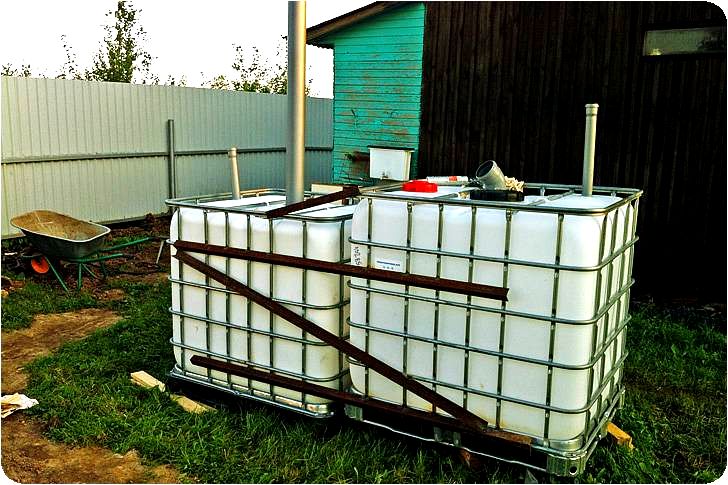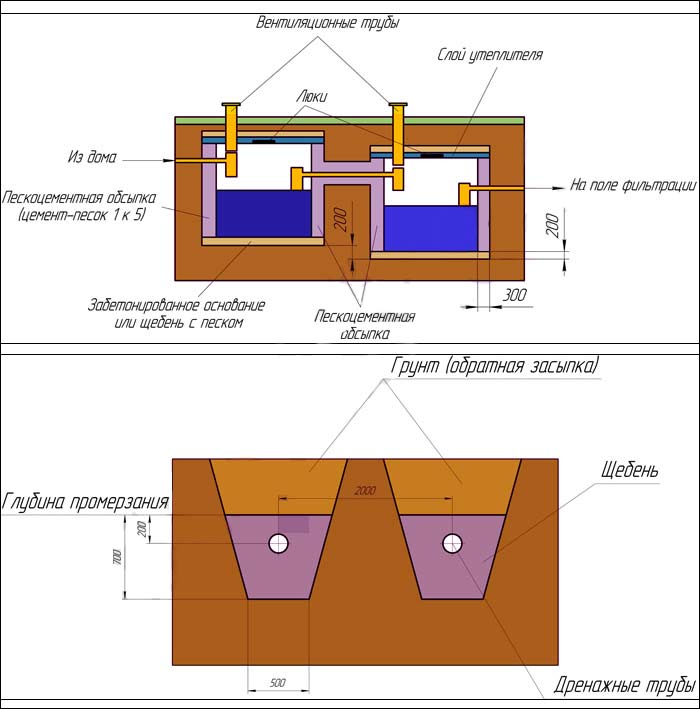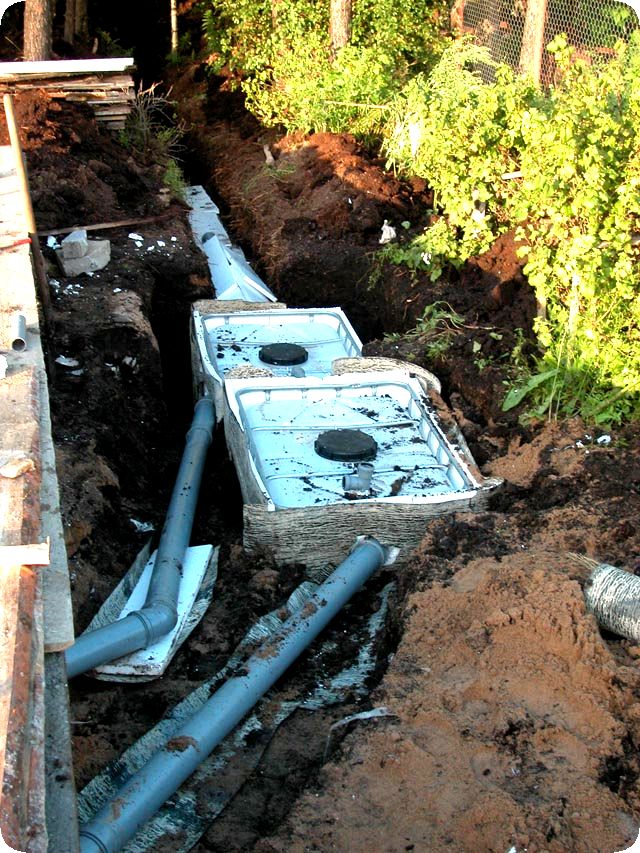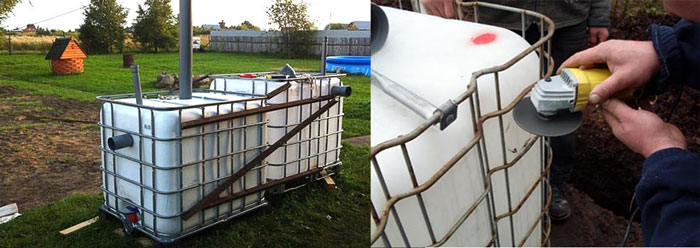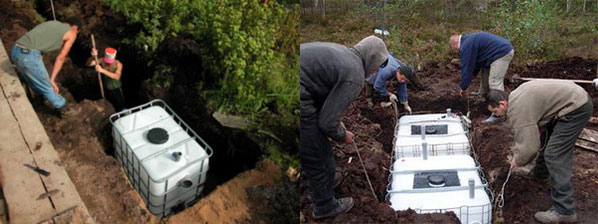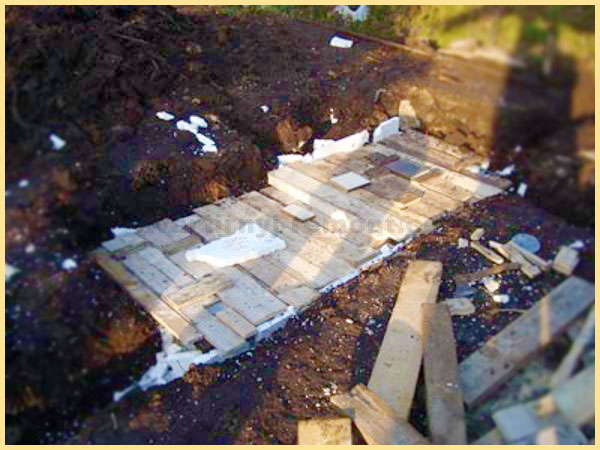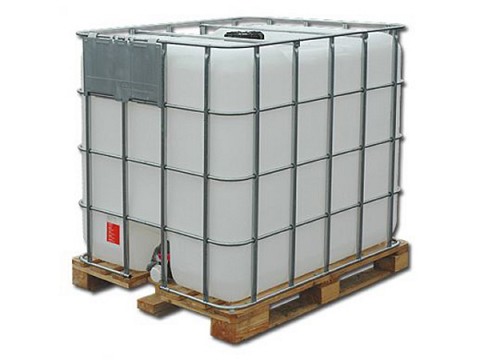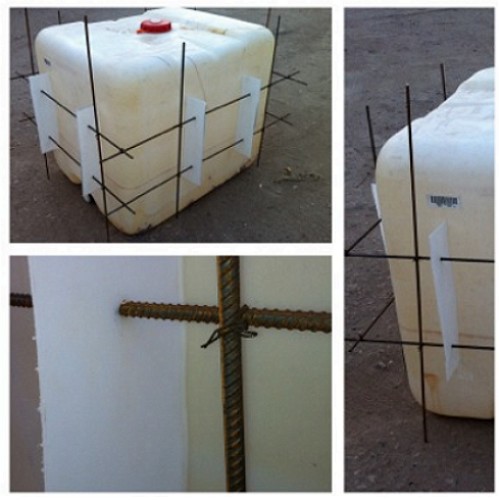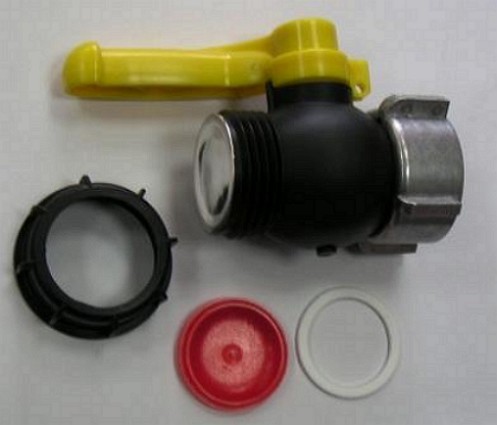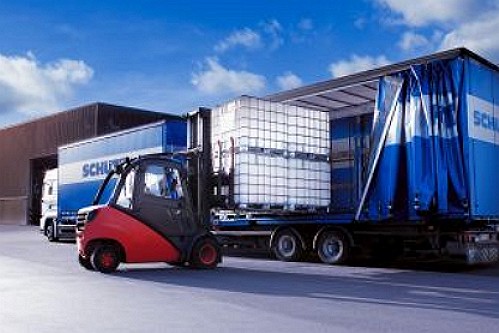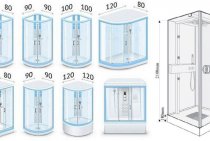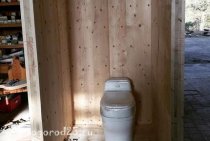Installation
The bottom of the excavated pit is pre-concreted to prevent erosion of the soil under the influence of the huge weight of the structure and the close occurrence of surface water.
After the structure is immersed in the pit, the walls of the septic tank and the pipeline are insulated with foam plastic. A concrete solution is also poured between the walls of the containers and the soil. This procedure can be omitted if the soil is not subject to shedding, erosion. Now water is poured into the tank, and the structure is covered with sand.
It is not difficult to build a post-treatment system, especially in places where there is sandy soil. A semblance of a well up to one meter deep is being built. An outlet pipe is connected to it.
During operation, it is recommended to conduct a periodic inspection, carefully examining the wide pipes that were installed in the septic tanks. Inside can be found polyethylene, fatty substances that contaminate containers, but do not undergo rapid decomposition. If such traces of contamination are found, they are removed using improvised means.

It is also important to check the bottom of the containers with a long pole. If a large amount of solid deposits have accumulated there, they must be removed:
- using the services of special equipment;
- pumping out the contents with a fecal pump.
Sometimes manufacturers recommend purchasing special bacteria for septic tanks, which can significantly speed up the process of decomposition of organic waste. However, as practice shows, you can do without additional costs by refusing to purchase such bacteria.
Nature itself took care of helping summer residents to solve such a problem. Microorganisms that feed on organic matter actively multiply and, without additional “requests” from the owners of summer cottages, resolve the issue of organic utilization.

It will not be difficult to build a septic tank from Eurocubes according to a pre-prepared scheme, if all the work is done correctly and high-quality materials are selected. A self-made sewer device can last up to 10 years without pumping.
What are eurocubes, their advantages and disadvantages
For the transportation of various liquids for technical purposes, special plastic containers are used. Additionally, for security reasons, it is placed in a metal frame. The volume of such containers reaches one cubic meter.
However, after the plastic container has fulfilled its original purpose, it is not recycled, but is reused. Most summer residents actively use such plastic containers for arranging septic tanks.

Plastic containers are ideal for the implementation of technical tasks to create an individual "sewerage". Clear benefits include:
- light weight of the product, due to which the construction process and subsequent installation are carried out manually without the need for special equipment;
- affordable cost;
- you can purchase both new products and those that have already been in use (used eurocubes have an even more attractive price);
- the plastic from which eurocubes are made has increased resistance to aggressive environments;
- the presence of a metal frame made of galvanized steel helps to reduce soil pressure on the main structure;
- high level of tightness;
- long service life;
- ease of maintenance and use.
Along with the advantages, eurocubes also have some disadvantages that are important to consider when constructing an alternative sewage system.The plastic construction, due to its light weight, can move from the place where it was originally installed
This happens under the influence of groundwater, which are close to the surface.
The plastic construction, due to its light weight, can move from the place where it was originally installed. This happens under the influence of groundwater, which are close to the surface.
As a result of the mobility of the soil, the metal structure may not be able to withstand the resulting pressure, and as a result, the container is deformed.
It is possible to prevent such undesirable consequences if, in advance, at the stage of constructing an individual sewage system, the base is poured with concrete, and then the space between the walls of the dug pit and the tank is poured with concrete mortar.
Construction of a septic tank
For a house and a summer residence, it is recommended to build a structure consisting of two septic tanks. If during the construction of a sewerage system based on containers it is impossible to do without the use of special equipment, then it is impossible to refuse the help of friends.

Firstly, it will be necessary to carry out earthworks in large volumes, to dig pits of decent depth.
Secondly, immersing septic tanks into dug pits, despite their low weight, is also quite problematic due to their large dimensions.
It is also important to consider that such a home-made cleaning device is not capable of cleaning drains in full, but only half. For this reason, it is important to worry about additional equipment of the structure with filters.
Before proceeding with the installation of a septic tank, it is necessary to calculate how much water is consumed daily by all residents. It is good if counters are installed in the house. If they are not there, you will have to spend time and calculate the volume of water consumption.
The result obtained must be multiplied by three to find out what volume of the septic tank should be obtained
The first important requirement is that the volume of the septic tank must contain the drains for three days.

Now you need to find a suitable place to install a septic tank from eurocubes with your own hands according to the scheme
Since the containers will be connected by pipes, it is very important that they are placed horizontally evenly, without any bends. If even a slight slope is allowed, the speed of the drains will slow down, and dirt and debris will concentrate in the inner space of the pipes, provoking a deterioration in the work of the drains
It is easier to understand the features of the construction of sewage from Eurocubes by watching a video that provides step-by-step instructions.
The construction process begins with earthworks:
- digging a trench (digging a trench for laying pipes through which drains will fall into the first tank);
- digging recesses for installing eurocubes (the parameters of the recess should be set based on the length, width, height of the eurocube, to which 15 cm are added - this additional space will subsequently be poured with concrete).
Pipe laying is carried out at a depth of no more than three meters from the surface of the earth
It is also important to dig such a trench so that the pipes are located below the freezing level of the ground.

The next step is the construction of a post-treatment system, which can be in the following variations:
- on the fields of filtration;
- in the filter well;
- on filter beds.
After such preparatory work, you can proceed to the conversion of two containers into a septic tank. This will require:
- pipes;
- tees;
- other consumables.
All joints must be sealed to prevent the occurrence of sewage leaks. Sewer pipes are connected at a distance of 20 cm below the upper edge of the tank.
A hole is cut inside the eurocube into which 2 tees are mounted. The joints are also subjected to careful waterproofing sealing.
The inlet pipe and the pipe pointing up are connected to the first tee.The main purpose of such a vertical pipe is to create conditions for a comfortable revision and cleaning of the system in the future.
The second tee is necessary in order to connect the two containers to each other using a pipe. Also, another pipe of smaller diameter is attached to the second tee, which serves for ventilation.

The photo shows that the outlet and inlet of the first container should be at different levels. The input should be higher and the output lower.
If the project involves the use of not one, but several containers, then each of the subsequent ones is set 20 cm lower than the previous one. The most common variant of individual sewerage are structures consisting of one or no more than three containers.
The pipe leading effluents from the last tank to the post-treatment filter systems must be equipped with a check valve.

The nuances of making a eurocube
You can make a septic tank with your own hands from 2-3 eurocubes connected in turn.
Eurocubes should be located at different levels, i.e. each will be lower than the previous one, then the drains will flow from one eurocube to another.
During the cleaning process, they will be broken down by anaerobic bacteria.
In order for a do-it-yourself septic tank made of eurocubes to exist for a long time without pumping out, it is necessary to fill in biologically active substances during the installation process, after interacting with which, the purified liquid is absorbed into the soil.
Silt can be removed once every few years, leaving an appropriate hole in the eurocube for this.
Advantages of a septic tank from an eurocube
- Resistant to sufficiently large loads;
- High tightness;
- Ease of installation of pipes in eurocubes;
- Resists the effects of chemicals;
- democratic value;
- Does not require special care;
- Light weight;
- With the accuracy of self-assembly, an excellent septic tank is obtained.
Cons of using Eurocube for septic tanks:
- The need for good fastening of the eurocube in the ground, or concreting, because due to its low weight, groundwater can push it out of the ground to the surface;
- Possible deformation of the surface of the eurocube, both in severe frosts and at too high loads.
Do-it-yourself Eurocube installation
Self-installation of a septic tank from eurocubes in the country includes several stages:
- It is necessary to calculate the volume of the tank. Since sufficient purification occurs in 3 days, the volume of the tank should include three times the daily volume of water consumption. For example, if 4 people live in a house, who use 150 liters each per day, then 600 liters must be multiplied by 3 and we get a total of 1800 liters. Thus, you need to buy 3 containers for a septic tank from 3 eurocubes with a volume of approximately 1.8 m3 each. You should take a septic tank with a volume slightly larger than calculated if you often have guests.
- Excavation. First of all, you need to start preparing trenches for pipes for a septic tank and a pit. Dig a hole 30 cm wider than the Eurocube itself. When calculating the depth, consider the dimensions of the concrete base, insulation and the zero temperature point. It must be remembered that the pipes run with a slope of 3 cm per meter, and also lie below the zero temperature point. The bottom of the pit is poured with concrete and hinges are installed for attaching the eurocube. Before concrete is poured, a sand cushion is usually placed at the bottom of the pit under the septic tank pipes.
- Construction collection. The first 2 eurocubes are connected to each other and to the sewer pipe, an overflow outlet is placed between the 2nd and 3rd eurocubes. The latter is directly connected to the filter field.
In order to carry out the installation of a septic tank, it is necessary to have eurocubes, several pipes with a cross section of 150 mm (their number varies and depends on the number of ventilation, transitions between tanks), as well as 6 adapters.
At the beginning, it is required to make cuts for tees in the necks of the eurocube. After 20 cm from the top down, make passages for the outlet pipe, which must be connected to the tee inside the chamber.
Next, on the opposite side of the eurocube, you need to cut a pass 40 cm from the top. Don't forget to make a slot for ventilation in the lid, and install each camera exactly 20 cm below.
With self-installation of a septic tank, it is necessary to seal the junctions of the pipe with the Eurocube with high quality.
- Pit processing. To protect the eurocube from deformation, a mixture of cement and sand is used 5: 1, respectively. The top of the structure is covered with this mixture several times, it is necessary to press each layer.
In order to prevent deformation of the eurocube walls from soil pressure during installation, fill it with water. You will also need penoizol in order to cover the upper surface of the septic tank.
How to extend the life of a septic tank from eurocubes
The septic tank does not require special maintenance, but some points should be considered in order to extend its useful life:
- Once every couple of years, it is required to remove the sediment from the tank;
- Periodically add supplements.
A do-it-yourself septic tank made of eurocubes is an economical and excellent option for its use in any climate zone.
What is eurocube
Eurocube is a volumetric container made of non-food plastic, manufactured in an industrial way. Eurocube belongs to the category of medium-tonnage containers (volume 1000 l.)
Structurally, the eurocube consists of an outer package and a plastic "flask" IBC container.
Galvanized steel crate is used as outer packaging. The packaging is located on a pallet made of plastic, less often metal. The Eurocube is made of low-pressure polyethylene. In the upper part of the "flask" there is a filler neck with a polyethylene cap. The diameter of the filler hole is 150 mm. In the lower part there is a drain cock equipped with a plunger or ball valve.
The drain cock is located in such a way that it practically does not go beyond the overall dimensions of the eurocube. With all its appearance, the durable and capacious design of the eurocube makes it clear that we have a reusable instance. What, in fact, the compatriots took advantage of, equipping the eurocube for a septic tank.
In their "European homeland" cubes are used for transportation and storage of liquid or bulk cargoes in the chemical, oil, food and pharmaceutical industries. So why not give a second life to a handy used container. Moreover, the scheme of a septic tank from Eurocubes is simple and affordable!
